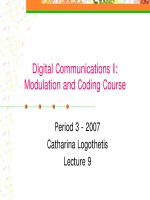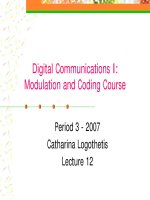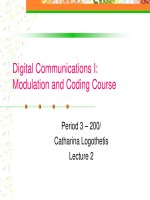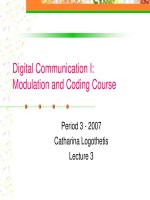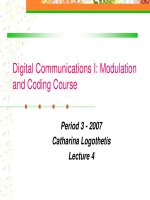Digital Communication I: Modulation and Coding Course-Lecture 2 potx
Bạn đang xem bản rút gọn của tài liệu. Xem và tải ngay bản đầy đủ của tài liệu tại đây (461.46 KB, 22 trang )
Digital Communications I:
Modulation and Coding Course
Term 3 – 2008
Catharina Logothetis
Lecture 2
Lecture 2 2
Last time, we talked about:
Important features of digital communication
systems
Some basic concepts and definitions such as
as signal classification, spectral density,
random process, linear systems and signal
bandwidth.
Lecture 2 3
Today, we are going to talk about:
The first important step in any DCS:
Transforming the information source to a form
compatible with a digital system
Lecture 2 4
Encode
Transmit
Pulse
modulate
Sample Quantize
Demodulate/
Detect
Channel
Receive
Low-pass
filter
Decode
Pulse
waveforms
Bit stream
Format
Format
Digital info.
Textual
info.
Analog
info.
Textual
info.
Analog
info.
Digital info.
source
sink
Formatting and transmission of baseband signal
Lecture 2 5
Format analog signals
To transform an analog waveform into a form
that is compatible with a digital
communication system, the following steps
are taken:
1. Sampling
2. Quantization and encoding
3. Baseband transmission
Lecture 2 6
Sampling
Time domain Frequency domain
)()()( txtxtx
s
×=
δ
)()()( fXfXfX
s
∗=
δ
|)(| fX
)(tx
|)(| fX
δ
|)(| fX
s
)(tx
s
)(tx
δ
Lecture 2 7
Aliasing effect
LP filter
Nyquist rate
aliasing
Lecture 2 8
Sampling theorem
Sampling theorem: A bandlimited signal
with no spectral components beyond , can
be uniquely determined by values sampled at
uniform intervals of
The sampling rate, is
called Nyquist rate.
Sampling
process
Analog
signal
Pulse amplitude
modulated (PAM) signal
Lecture 2 9
Quantization
Amplitude quantizing: Mapping samples of a continuous
amplitude waveform to a finite set of amplitudes.
In
Out
Quantized
values
Average quantization noise power
Signal peak power
Signal power to average
quantization noise power
Lecture 2 10
Encoding (PCM)
A uniform linear quantizer is called Pulse Code
Modulation (PCM).
Pulse code modulation (PCM): Encoding the quantized
signals into a digital word (PCM word or codeword).
Each quantized sample is digitally encoded into an l bits
codeword where L in the number of quantization levels and
Lecture 2 11
Quantization example
t
Ts: sampling time
x(nTs): sampled values
xq(nTs): quantized values
boundaries
Quant. levels
111 3.1867
110 2.2762
101 1.3657
100 0.4552
011 -0.4552
010 -1.3657
001 -2.2762
000 -3.1867
PCM
codeword
110 110 111 110 100 010 011 100 100 011
PCM sequence
amplitude
x(t)
Lecture 2 12
Quantization error
Quantizing error: The difference between the input and
output of a quantizer
)()(
ˆ
)( txtxte −=
+
)(tx
)(
ˆ
tx
)()(
ˆ
)(
txtx
te
−
=
AGC
x
)(xqy
=
Qauntizer
Process of quantizing noise
)(tx
)(
ˆ
tx
)(te
Model of quantizing noise
Lecture 2 13
Quantization error …
Quantizing error:
Granular or linear errors happen for inputs within the
dynamic range of quantizer
Saturation errors happen for inputs outside the dynamic
range of quantizer
Saturation errors are larger than linear errors
Saturation errors can be avoided by proper tuning of AGC
Quantization noise variance:
2
Sat
2
Lin
222
)()(})]({[
σσσ
+==−=
∫
∞
∞−
dxxpxexqx
q
E
ll
L
l
l
qxp
q
)(
12
2
12/
0
2
2
Lin
∑
−
=
=
σ
Uniform q.
12
2
2
Lin
q
=
σ
Lecture 2 14
Uniform and non-uniform quant.
Uniform (linear) quantizing:
No assumption about amplitude statistics and correlation
properties of the input.
Not using the user-related specifications
Robust to small changes in input statistic by not finely tuned to a
specific set of input parameters
Simple implementation
Application of linear quantizer:
Signal processing, graphic and display applications, process
control applications
Non-uniform quantizing:
Using the input statistics to tune quantizer parameters
Larger SNR than uniform quantizing with same number of levels
Non-uniform intervals in the dynamic range with same
quantization noise variance
Application of non-uniform quantizer:
Commonly used for speech
Lecture 2 15
Non-uniform quantization
It is achieved by uniformly quantizing the “compressed” signal.
At the receiver, an inverse compression characteristic, called
“expansion” is employed to avoid signal distortion.
compression+expansion companding
)(ty
)(tx
)(
ˆ
ty
)(
ˆ
tx
x
)(xCy =
x
ˆ
y
ˆ
Compress Qauntize
Channel
Expand
Transmitter Receiver
Lecture 2 16
Statistics of speech amplitudes
In speech, weak signals are more frequent than strong ones.
Using equal step sizes (uniform quantizer) gives low for weak
signals and high for strong signals.
Adjusting the step size of the quantizer by taking into account the speech statistics
improves the SNR for the input range.
0.0
1.0
0.5
1.0
2.0
3.0
Normalized magnitude of speech signal
Probability density function
q
N
S
q
N
S
Lecture 2 17
Baseband transmission
To transmit information through physical
channels, PCM sequences (codewords) are
transformed to pulses (waveforms).
Each waveform carries a symbol from a set of size M.
Each transmit symbol represents bits of
the PCM words.
PCM waveforms (line codes) are used for binary
symbols (M=2).
M-ary pulse modulation are used for non-binary
symbols (M>2).
Mk
2
log=
Lecture 2 18
PCM waveforms
PCM waveforms category:
Phase encoded
Multilevel binary
Nonreturn-to-zero (NRZ)
Return-to-zero (RZ)
1 0 1 1 0
0 T 2T 3T 4T 5T
+V
-V
+V
0
+V
0
-V
1 0 1 1 0
0 T 2T 3T 4T 5T
+V
-V
+V
-V
+V
0
-V
NRZ-L
Unipolar-RZ
Bipolar-RZ
Manchester
Miller
Dicode NRZ
Lecture 2 19
PCM waveforms …
Criteria for comparing and selecting PCM
waveforms:
Spectral characteristics (power spectral density and
bandwidth efficiency)
Bit synchronization capability
Error detection capability
Interference and noise immunity
Implementation cost and complexity
Lecture 2 20
Spectra of PCM waveforms
Lecture 2 21
M-ary pulse modulation
M-ary pulse modulations category:
M-ary pulse-amplitude modulation (PAM)
M-ary pulse-position modulation (PPM)
M-ary pulse-duration modulation (PDM)
M-ary PAM is a multi-level signaling where each
symbol takes one of the M allowable amplitude levels,
each representing bits of PCM words.
For a given data rate, M-ary PAM (M>2) requires less
bandwidth than binary PCM.
For a given average pulse power, binary PCM is
easier to detect than M-ary PAM (M>2).
Mk
2
log=
Lecture 2 22
PAM example


